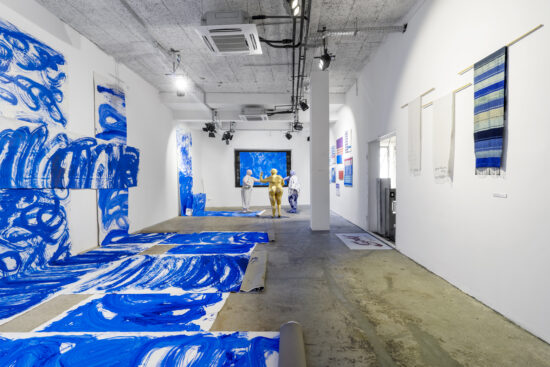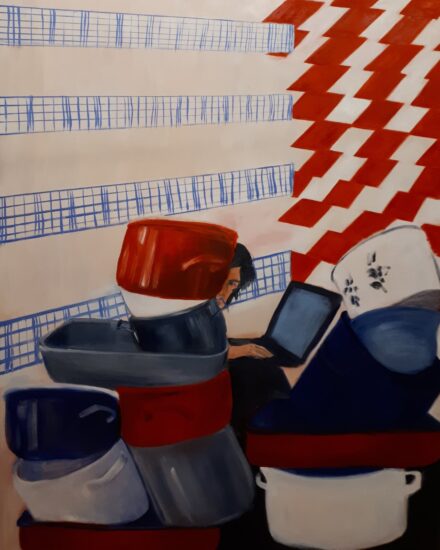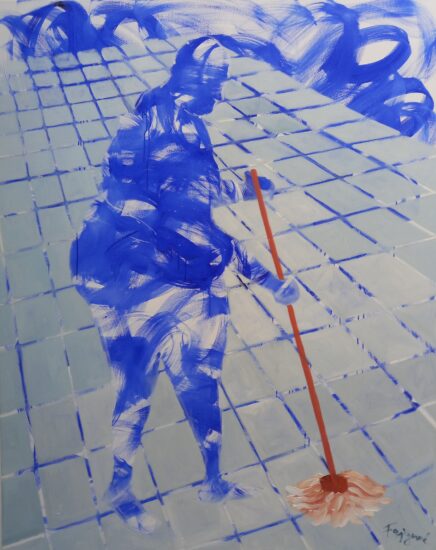Contributing author Caitlin Swindell is the Curator of Collections and Exhibitions at the Lowe Art Museum, University of Miami. She has held curatorial positions at the Denver Art Museum and the Museum of Contemporary Art (MOCA) Jacksonville, worked as an art consultant in Santa Fe, NM, and completed internships at various institutions, including the Museum of Fine Arts, Boston, the Smithsonian National Portrait Gallery, and the New Orleans Museum of Art.
Andrea Fajgerné Dudás (b. 1985) is an artist, contemporary painter, housewife, feminist, performance artist, and a mother of two. She is represented by Erika Deák Gallery in Budapest, Hungary. For more information, visit the artist’s website at https://fajgerne.com/.
I first met Andrea Fajgerné in spring of 2022 as part of a two-week curatorial residency in Budapest, Hungary. My colleagues and I visited Fajgerné’s solo exhibition entitled Catalyst of the Housewife at the Godot Institute of Contemporary Art where we met Fajgerné and spoke with her about her artistic practice and the works on view. This interview sheds light on much of what she spoke about then—gender inequality, and the spheres within which women work. It also touches on other series of hers that are particularly relevant to the dialogue surrounding female identity and Hungarian culture.
Andrea Fajgerné’s work spans painting, photography, sculpture, site-specific installations, performance, and EAT-ART happenings—in which viewers are invited to eat a food component of an installation while also viewing or responding to other artworks. She completed her DLA (Doctor of Liberal Art) at the Hungarian University of Fine Arts from 2013-2019 and has exhibited her work extensively. Her art historical interests and areas of research include the methods of female painters from the 1400s to the mid-1900s.

Installation of exhibition Catalyst of the Housewife, 2022 at Godot Institute of Contemporary Art, Budapest, Hungary.
Caitlin: It is fantastic to get to speak to you again after all this time. Perhaps you could start by sharing a bit about your early career. When did you begin working as an artist? Have you always been artistically inclined?
Andrea: I don’t come from a family of artists. I was going to be a businesswoman, but I was sensitive to the world and interested in art. I decided to become an artist at the age of 16, inspired by Frida Kahlo’s depictions of her knit eyebrows and moustache, which at the time made me wonder what to do with body hair. Then I became very determined and purposeful. I graduated from the Hungarian University of Fine Arts with a degree in painting; my advisor was Orshi Drozdik. Female painters and oeuvres that were pushed aside or excluded from the canon of art history have played an important role in my art since 2009. In my dissertation, I have focused on feminist art practices that thematise housework and kitchen chores performed by women. As an integral part of my practice, Eat Art allows me to formulate experiences and feelings that my painting cannot express.
Caitlin: Since identity is a large part of your work, tell us about the act of taking your husband’s name—a traditional Hungarian custom. How do people react to this?
Andrea: I declare myself a woman artist and a feminist artist. I live in a traditional nuclear family, and with my name, I also declare that I am a married woman. A feminist and wife who takes on traditional female roles and voices taboo topics such as infertility and artificial insemination. I easily identify with the desires, goals and determination of first-generation feminists, but I grew up in gender parity and see men and women as equals. So, after my marriage, according to the traditional Hungarian naming conventions, I took my husband’s name as a radical artistic gesture (Mrs. Fajger, in which the suffix -né denotes belonging to a man), which I have used as an artist’s name ever since.
I took my husband’s name according to traditional Hungarian custom, which I interpret both as belonging to a man and an artistic statement. I explore the intertwining of female identity, social roles and patriarchal conventions. As a feminist, I also create confusion in the contemporary art milieu with my conservative female name. In my paintings entitled Compromise, I depict a new type of marriage in which husband and wife are equal partners and help each other achieve their goals.
Caitlin: What is it like to be a female artist in Hungary? How do you experience and reflect on patriarchal conventions and social roles?
Andrea: In today’s Hungary, there is a national-conservative concept according to what a woman’s place is at home, in the family, in the kitchen, and in the household with the children. In my painting Picaboo Housewife’s Art, the woman hides behind the pile of unwashed dishes in the pantry; she has to become invisible in order to do the (creative) work necessary for her career and fulfillment. As a white, middle-class woman from Central-Eastern Europe, I am aware of my situation. My life is underdeveloped compared to the West, and nonetheless, it is happy and calm for third-world countries. I am in an ‘in between’ situation like my painting is situated between figuration and abstraction. In Hungary, feminism is still “immature,” it is like a “green tomato.” I express this idea most clearly in my eponymous “Green Tomato” jam. Women’s attitude towards female art and feminism has not changed since socialism in Hungary. However, the world has changed so much that women often arouse debates among other women about feminism. However, in the art world, a man still has a better chance to be successful, as to this day, childbirth determines women’s careers and their perception in society. I can say that women must defend their interests not only against men, but there are also conflicts between women. bell hooks draws our attention to how the white woman becomes domineering and exploitative, just like the exploitative heterosexual white man she theoretically fights. If she becomes dominant, she becomes just as oppressive. In conclusion, I attempt to pursue the career of a professional artist in which I can stay true to myself while being a wife and a mother of two and try to reconcile the career-parenting-household triad. I aspire to maintain equal relationships and do my best not to become oppressive.
Caitlin: Are there artists that inspire you or that you feel are important to the Feminist art movement/s? What impact have they had on you?
Andrea: In 2009, when I bought Frances Borzello’s book entitled Femmes au Miroir in Paris, I decided that women painters and forgotten female artists would be given a prominent role in my art. To this end, I constantly reinterpret them, incorporate their work into my practice, and my goal is to make them part of our collective memory. Unfortunately, in Hungary, few books have been published about women painters, and there are hardly any books about women painters in universities. Their stories are not known. I would like to make up for this. I have a lot of literature from America, I have been to New York twice, and I have bought many books in English and German from Germany and Vienna. I pursued a doctorate to teach the history of women painters in my country alongside my art career.
But to give you a short list with some of the artists that have had an impact on my practice: Frida Kahlo, Mierle Laderman Ukeles, VALIE EXPORT, Georgia O’Keeffe, Janine Antoni, Lily Martin Spencer, Lee Krasner, Birgit Jürgenssen, Carolee Schneemann, Francesca Woodman, Sonja Delaunay, Zinaida Sererjakova, Meret Oppenheim, Natalja Goncsarova, Elisabeth Butler, Judy Chicago.
Caitlin: The notion of care—both as a mother and partner appears throughout your work. Geometric abstraction in your painting evokes some of the patterns of tea towels also incorporated in Catalyst of a Housewife. In addition to tea towels, dishware is another key element. Tell us about these materials and what draws you to them.
Andrea: Care is a concept that is fundamentally linked to being a woman in all sorts of negative and positive senses, both as an obligation and as an expectation. In my NO FOMO series, the concept of care has come to the fore. It was Ukeles’ Care performance that really inspired me and Loving Care performance from Janine Antoni. Therefore, the title and message of all my pictures are about care. And the titles of the pictures are puns on the word care: Care-free, Ba-care, Childcare, Who cares?, Self-care.
During the pandemic, everything was relegated to the home, to the intimate sphere, and with the closure of institutions, the boundaries between work and private life ceased to exist. As an artist with young children, I had to become a kindergarten teacher, a teacher, a housekeeper, while working and creating when I had the energy left. Not only did the pandemic push women back into the household, but in recent decades we have taken a step backwards in gender equality. You would think that in such a radical life situation, which affects everyone, the pressure from the scene, the external and internal expectations, the constant need to perform would disappear. However, the desires to prove oneself and the feeling of FOMO (the fear of missing out) have only intensified, and expectations remain the same because artists are under the illusion that all they do during a pandemic is create and create.
In my art, I was inspired by Hélène Cixous’s writings on female language and speech, which incited her to find her female voice. I deal with the marginal issues of female existence. Women need to be invisible to do the creative work necessary for their career and fulfillment. Birgit Jürgensen’s Fensterputzen (1975) and Hausfrau (1974) had a great influence on me. The colours of ultramarine and vermillion are the typical colours of kitchen towels but basic materials of painting which can make these ordinary, menial, and invisible works nobler. I consider kitchen towels as geometrical abstract artworks in an everyday-life environment. The kitchen towel symbolizes the abstract painting of our weekdays; it is constantly in front of our sight and engrained in our consciousness. Brushstrokes and paints demonstrate cleaning. Gestures represent rubbing and wiping. In my abstract paintings, I depict tea towels which are minimalist tools that constantly decorate kitchens. I deconstruct tea towels, divide them into elements, and put them into a new structure. I work with the gesture of cleaning, while the geometric system of kitchen towels indicates the grid.
Caitlin: How do you select textiles – are there certain motifs that carry meaning in Hungarian culture?
Andrea: I take motifs and patterns from folk art and the world of tessellations used in the household and home, patterns for tablecloths, kitchen linen, and carpets.
[This is Part 1 of an in-depth interview with the artist. Click HERE to read Part 2!]


